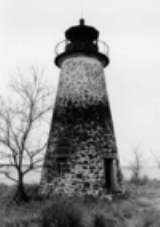
Pooles Island Light
Encyclopedia
Pooles Island Light is the oldest lighthouse
still standing in Maryland and the fourth oldest in the Chesapeake Bay
area.
, but over the years the name was changed, possibly to reflect the numerous springs and pools on the island. The island was famed in the 18th and 19th centuries for its fertility, particularly for the peaches raised there in the 1880s and '90s. As it lies near the center of the bay near the mouth of the Gunpowder River, it was one of the first places considered for a lighthouse, and in 1824 Congress appropriated $5000 for construction of a light. John Donahoo
and Simon Frieze won the contract to build it, the first of many lights constructed by Donahoo. The roughly constructed granite tower and keeper's house were joined three years later by a fog bell tower, the first in the state. In 1857 the original system of Argand lamps and reflectors was replaced by a fourth order Fresnel lens
.
As part of the establishment of Aberdeen Proving Ground
in 1917, Pooles Island was purchased by the federal government, and the light station turned over to the Army
. The light was automated the following year. In 1939, it was decommissioned, and the surrounding structures were torn down.
In 1994, the Army submitted a proposal to designate the lighthouse as a National Historic Monument, with the intent to restore it to service as a private navigational aid. As part of this effort a thorough renovation effort was made to protect and stabilize the structure.
According to the website of the Chesapeake Chapter of the United States Lighthouse Society
, the Pooles Island Light is "off limits to the general public because the island was used for bombing and shelling practice from 1918 through the early 1960's. There are many unexploded bombs and shells all over the island." http://www.cheslights.org/heritage/pooles.htm
Lighthouse
A lighthouse is a tower, building, or other type of structure designed to emit light from a system of lamps and lenses or, in older times, from a fire, and used as an aid to navigation for maritime pilots at sea or on inland waterways....
still standing in Maryland and the fourth oldest in the Chesapeake Bay
Chesapeake Bay
The Chesapeake Bay is the largest estuary in the United States. It lies off the Atlantic Ocean, surrounded by Maryland and Virginia. The Chesapeake Bay's drainage basin covers in the District of Columbia and parts of six states: New York, Pennsylvania, Delaware, Maryland, Virginia, and West...
area.
History
Pooles Island was originally named Powell's Island by John SmithJohn Smith of Jamestown
Captain John Smith Admiral of New England was an English soldier, explorer, and author. He was knighted for his services to Sigismund Bathory, Prince of Transylvania and friend Mózes Székely...
, but over the years the name was changed, possibly to reflect the numerous springs and pools on the island. The island was famed in the 18th and 19th centuries for its fertility, particularly for the peaches raised there in the 1880s and '90s. As it lies near the center of the bay near the mouth of the Gunpowder River, it was one of the first places considered for a lighthouse, and in 1824 Congress appropriated $5000 for construction of a light. John Donahoo
John Donahoo
John Donahoo was a lighthouse builder active in Maryland for much of the first half of the nineteenth century....
and Simon Frieze won the contract to build it, the first of many lights constructed by Donahoo. The roughly constructed granite tower and keeper's house were joined three years later by a fog bell tower, the first in the state. In 1857 the original system of Argand lamps and reflectors was replaced by a fourth order Fresnel lens
Fresnel lens
A Fresnel lens is a type of lens originally developed by French physicist Augustin-Jean Fresnel for lighthouses.The design allows the construction of lenses of large aperture and short focal length without the mass and volume of material that would be required by a lens of conventional design...
.
As part of the establishment of Aberdeen Proving Ground
Aberdeen Proving Ground
Aberdeen Proving Ground is a United States Army facility located near Aberdeen, Maryland, . Part of the facility is a census-designated place , which had a population of 3,116 at the 2000 census.- History :...
in 1917, Pooles Island was purchased by the federal government, and the light station turned over to the Army
United States Army
The United States Army is the main branch of the United States Armed Forces responsible for land-based military operations. It is the largest and oldest established branch of the U.S. military, and is one of seven U.S. uniformed services...
. The light was automated the following year. In 1939, it was decommissioned, and the surrounding structures were torn down.
In 1994, the Army submitted a proposal to designate the lighthouse as a National Historic Monument, with the intent to restore it to service as a private navigational aid. As part of this effort a thorough renovation effort was made to protect and stabilize the structure.
According to the website of the Chesapeake Chapter of the United States Lighthouse Society
United States Lighthouse Society
The United States Lighthouse Society is a non-profit organization dedicated to aiding in the restoration of American lighthouses and educating the public about their history. There are currently five chapters of the Society around the United States. Among other activities, it publishes The...
, the Pooles Island Light is "off limits to the general public because the island was used for bombing and shelling practice from 1918 through the early 1960's. There are many unexploded bombs and shells all over the island." http://www.cheslights.org/heritage/pooles.htm

